Have you ever wondered how to maximize your garden’s potential naturally? Companion planting isn’t just an old gardening trick—it’s a science-backed strategy that can transform your growing space. By strategically pairing plants that benefit each other, we can create thriving garden ecosystems without relying on chemicals or intensive interventions.
We’ve spent years researching and testing the most effective plant partnerships, and we’re excited to share these game-changing combinations with you. From pest control to improved flavor and increased yields, companion planting offers benefits that every gardener should take advantage of. Whether you’re working with a small balcony garden or acres of farmland, these natural plant relationships can revolutionize your growing success.
What Are Companion Plants and Why They Matter for Your Garden
Companion plants are species that provide mutual benefits when grown together in your garden. These plant partnerships work synergistically to enhance growth, deter pests, improve flavor, and increase yields naturally. Many gardeners have discovered that strategic plant pairings can transform their growing spaces into thriving ecosystems where each plant supports its neighbors.
The science behind companion planting reveals several key mechanisms at work. Plants communicate through chemical signals released through their roots and leaves, establishing beneficial relationships with neighboring species. Some companions act as natural pest deterrents by emitting scents that confuse or repel harmful insects. Tall plants often provide necessary shade for sun-sensitive varieties, creating microclimate protection that’s invaluable during intense summer heat.
Biodiversity represents one of the most compelling reasons to carry out companion planting in your garden. Gardens with diverse plant species naturally resist disease and pest outbreaks better than monoculture plantings. The complex web of plant interactions mimics natural ecosystems, reducing the need for chemical interventions and creating a more balanced growing environment. Your garden becomes more resilient to environmental stresses when multiple plant species work together.
Resource efficiency improves dramatically with strategic companion planting. Deep-rooted plants can access nutrients from lower soil layers and make them available to shallow-rooted neighbors. Nitrogen-fixing varieties like beans and peas capture atmospheric nitrogen and convert it to a form other plants can use. Space utilization becomes more effective when you pair plants with different growth habits, allowing you to grow more food in the same area.
The practical benefits of companion planting extend beyond just plant health. Many companion combinations actually enhance the flavor and nutritional value of your harvest. Certain herbs planted near vegetables can impart subtle flavor improvements while providing protection from pests. Your garden maintenance requirements often decrease with companion planting as the natural balance created requires less intervention from you.
10 Best Companion Plants for Vegetables in Your Garden
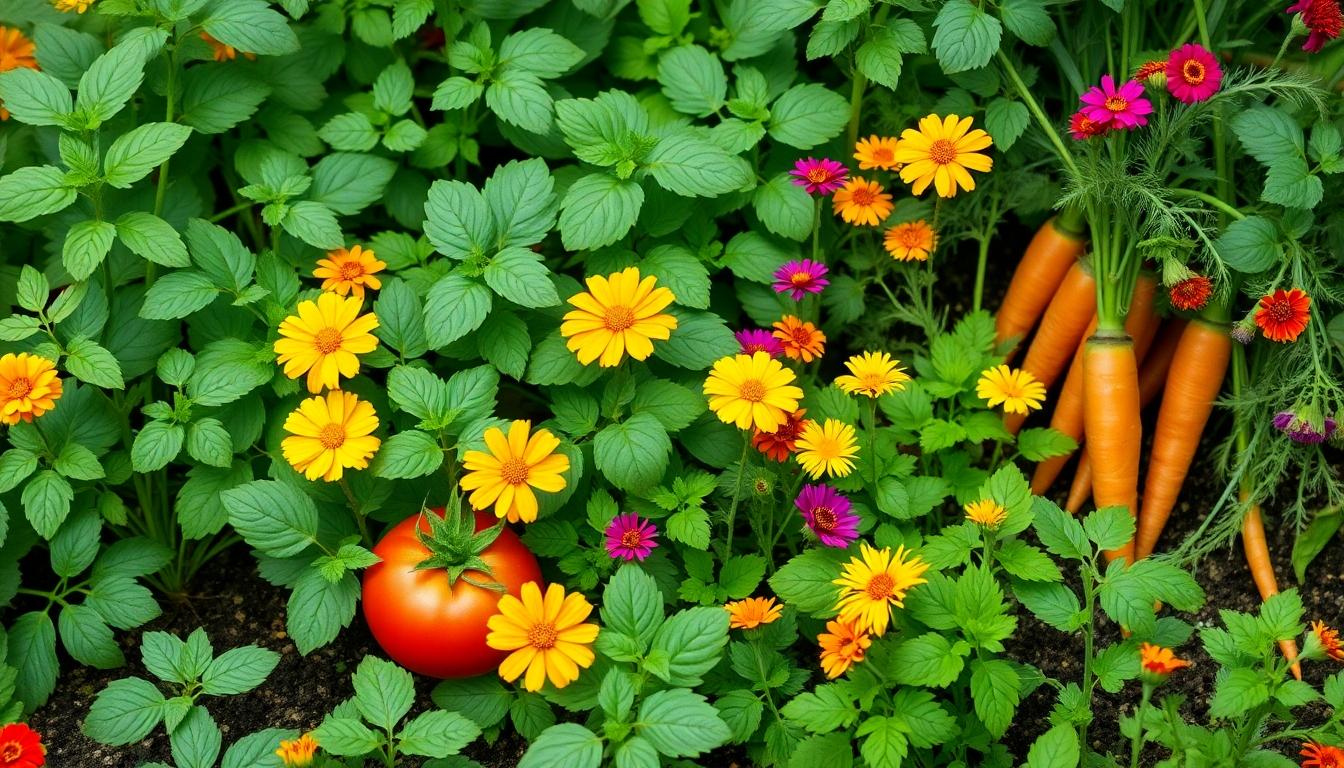
Now that we understand the science and benefits of companion planting, let’s explore the most effective plant partnerships for your vegetable garden. These combinations have been proven to enhance growth, deter pests, and improve harvests naturally.
Basil: The Tomato’s Best Friend
Basil serves as the perfect companion for tomatoes, improving their growth while repelling troublesome pests like thrips and whiteflies. Many gardeners report that tomatoes grown alongside basil develop superior flavor profiles. This aromatic herb doesn’t just benefit tomatoes—it also effectively deters aphids when planted near peppers or lettuce. Plant basil between tomato plants or around the perimeter of your tomato bed for maximum pest protection and growth enhancement.
Marigolds: Nature’s Pest Control Specialists
Marigolds function as natural pest control centers in vegetable gardens, repelling harmful nematodes, beetles, and aphids with their distinctive scent. Their bright flowers make attractive additions to gardens while providing serious protection for vulnerable vegetables. We recommend planting marigolds near tomatoes, cucumbers, or squash beds to shield these crops from soil-borne pests. Their root system releases compounds that deter harmful nematodes, making them particularly valuable for protecting root vegetables and fruiting plants from underground damage.
Nasturtiums: Attracting Beneficial Insects While Deterring Pests
Nasturtiums perform double duty in vegetable gardens by attracting pollinators while simultaneously repelling cucumber beetles, squash bugs, and whiteflies. Their vibrant blooms draw beneficial insects that help with pollination and pest control. Plant nasturtiums near cucumbers, radishes, or tomatoes to create a protective barrier against common garden pests. Their trailing habit makes them perfect for garden borders or as groundcover between vegetable rows, maximizing both their ornamental value and pest-deterring properties.
Tomatoes & Carrots
Tomatoes create beneficial shade for heat-sensitive carrots during summer months, protecting them from excessive sun exposure. They release solanine, a natural compound that deters many carrot pests. Carrots return the favor by aerating the soil around tomato roots, improving drainage and root development. This partnership demonstrates perfect symbiosis in the vegetable garden, with each plant addressing the other’s vulnerabilities.
Beans & Corn
Beans fix nitrogen in the soil, benefiting heavy feeders like corn that require abundant nutrients for optimal growth. Corn stalks provide natural support structures for pole beans to climb, eliminating the need for additional trellising. Native Americans traditionally used this combination along with squash in the “Three Sisters” planting method, showcasing this partnership’s ancient and proven effectiveness for maximizing garden space and yields.
Cucumbers & Radishes
Radishes deter cucumber beetles, protecting young cucumber plants during their vulnerable early growth stages. They mature quickly, loosening the soil for cucumber roots to spread easily as they develop. Plant radishes around the perimeter of cucumber hills or intersperse them throughout cucumber beds. Harvest the radishes as they mature, creating space for cucumber vines to expand while having already provided their pest-deterring benefits.
Lettuce & Onions
Onions repel aphids and slugs that typically plague lettuce crops, offering natural protection for these tender greens. Lettuce features shallow root systems that avoid competing with onions for nutrients and water resources. We’ve found this combination particularly effective in spring and fall gardens when pest pressure on lettuce increases. Plant onions in alternating rows or as borders around lettuce beds for comprehensive pest protection.
Broccoli & Beets
Beets grow harmoniously with broccoli because they use different soil nutrients, preventing resource competition. Their differing root depths—beets growing deeper than broccoli’s shallow roots—allow them to share garden space efficiently. This partnership maximizes yield per square foot while maintaining plant health. Plant beets between broccoli plants or in alternating rows for best results in limited garden spaces.
Dill & Cabbage
Dill attracts predatory wasps that control destructive cabbage pests like cabbage loopers and moths. These beneficial insects lay eggs on pest larvae, naturally reducing their populations without chemicals. Plant dill near cabbage, cauliflower, and other brassicas to create a natural pest management system. Allow some dill plants to flower to maximize their attraction to beneficial predatory insects.
Rosemary/Sage & Carrots
Rosemary, sage, and chives repel carrot flies, protecting carrots from one of their most important pest threats. Their strong aromatic compounds mask the scent of carrots that typically attracts these pests. Plant these herbs along the edges of carrot beds or intersperse them throughout the planting area. Their perennial nature means they’ll provide protection year after year while also offering culinary benefits to your kitchen.
7 Powerful Herb Companion Plants That Enhance Your Garden
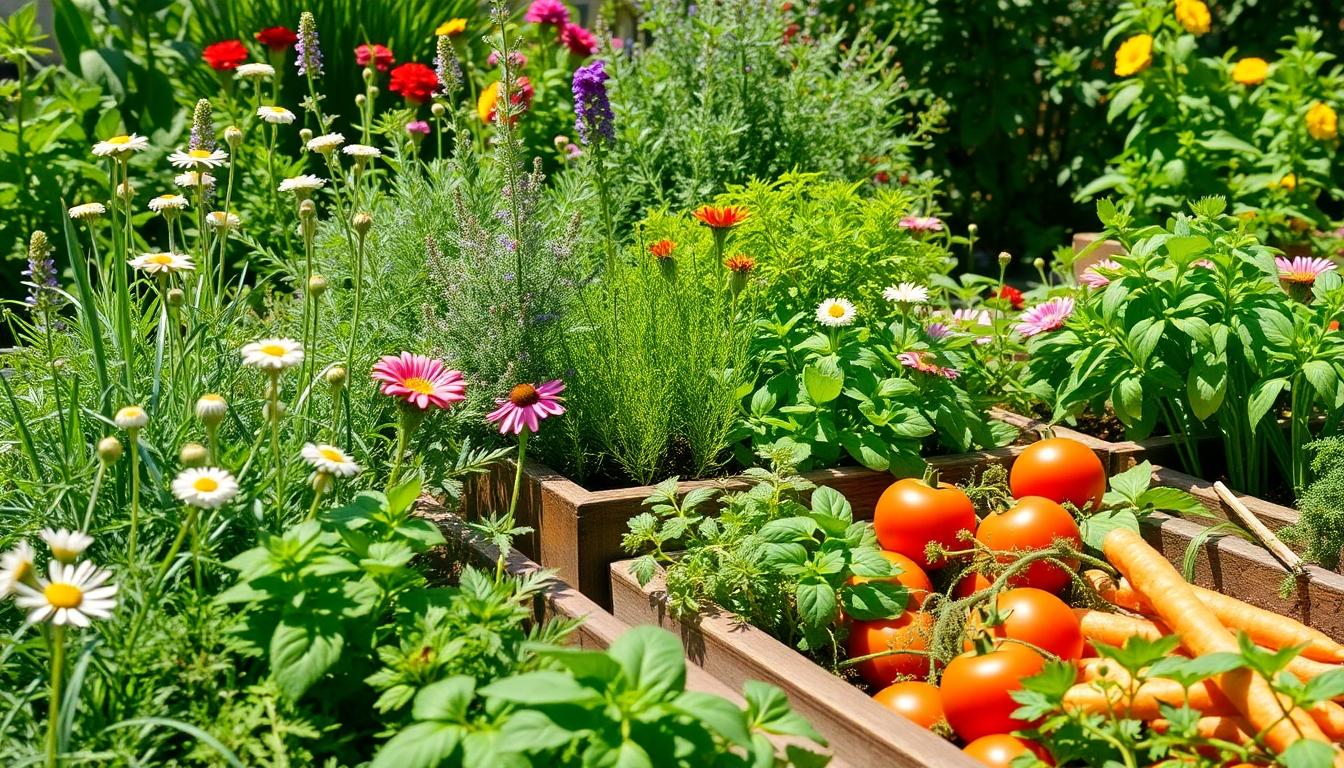
Herbs aren’t just flavorful additions to your kitchen—they’re also powerful allies in your garden. These versatile plants form beneficial relationships with vegetables and other plants, offering protection and growth benefits.
1. Chamomile: The Plant Nurse
Chamomile serves as a natural health booster for many garden plants. This gentle herb companions beautifully with cabbage, onions, and cucumbers, improving both their flavor and overall health. Garden productivity increases when chamomile is present because it enhances the essential oil production of neighboring herbs. Beneficial insects flock to chamomile flowers, creating a natural pest management system in your garden beds.
2. Chives: The Flavor Enhancer
Chives offer multiple benefits when strategically placed throughout your garden. These slender, aromatic plants improve the flavor and growth of carrots, tomatoes, broccoli, and cabbage. Aphid populations decrease significantly when chives are planted nearby vulnerable crops. Apple trees benefit enormously from chives planted beneath them, as they help prevent apple scab. Careful planning is necessary, but, since chives can stunt the growth of beans and peas.
3. Coriander (Cilantro): The Dual-Purpose Defender
Coriander pulls double duty in the garden by repelling harmful pests while attracting beneficial insects. This versatile herb works well alongside anise and potatoes, creating a protective barrier against aphids, spider mites, and potato beetles. Predatory wasps and hoverflies—natural enemies of many garden pests—are drawn to coriander’s delicate flowers. Fennel should be kept away from coriander as these two herbs compete rather than complement each other.
4. Cumin: The Specialized Guardian
Cumin offers targeted protection for exact crops in your garden. This aromatic herb companions particularly well with chickpeas and potatoes, repelling exact pests that commonly damage these crops. Careful placement is essential when working with cumin because it possesses allelopathic properties that can inhibit the growth of some neighboring plants. Strategic use of cumin can create protected zones for susceptible vegetables.
5. Mint: A Powerful Pest Deterrent
Mint excels as one of the garden’s most effective natural pest controllers. This aromatic herb actively repels aphids and many other unwanted insects that might otherwise damage your vegetables. Tomatoes, peas, and carrots particularly benefit from having mint as a companion, showing improved health and reduced pest pressure. Containment is crucial when planting mint since its vigorous growth habit can quickly overtake garden beds. Using containers or barriers will help harness mint’s benefits while preventing it from becoming invasive.
6. Rosemary: Protection and Flavor in One Plant
Rosemary delivers multiple benefits through its aromatic oils and sturdy presence in the garden. This Mediterranean herb offers exceptional protection against destructive pests like carrot flies while simultaneously improving the flavor profile of neighboring vegetables. Carrots, beans, and various cabbage family plants thrive when planted near rosemary, developing better taste and showing increased resistance to common pests. Potatoes generally don’t pair well with rosemary, so keeping these plants separated will ensure better results for both. The woody stems of mature rosemary plants also provide structural support for some climbing vegetables.
7. Basil: The Tomato’s Best Friend
Basil creates powerful synergies with exact garden vegetables, particularly those in the nightshade family. This aromatic herb famously pairs with tomatoes, not only improving their flavor but also repelling tomato hornworms and other destructive pests. Pepper plants show remarkable improvement when grown alongside basil, with both crops benefiting from the relationship. Various other herbs grow compatibly with basil, creating aromatic garden sections that deter pests while providing culinary herbs. The strong scent of basil masks the smell of valuable crops, confusing pests that might otherwise locate and damage your vegetables.
5 Companion Plants That Improve Soil Health Naturally
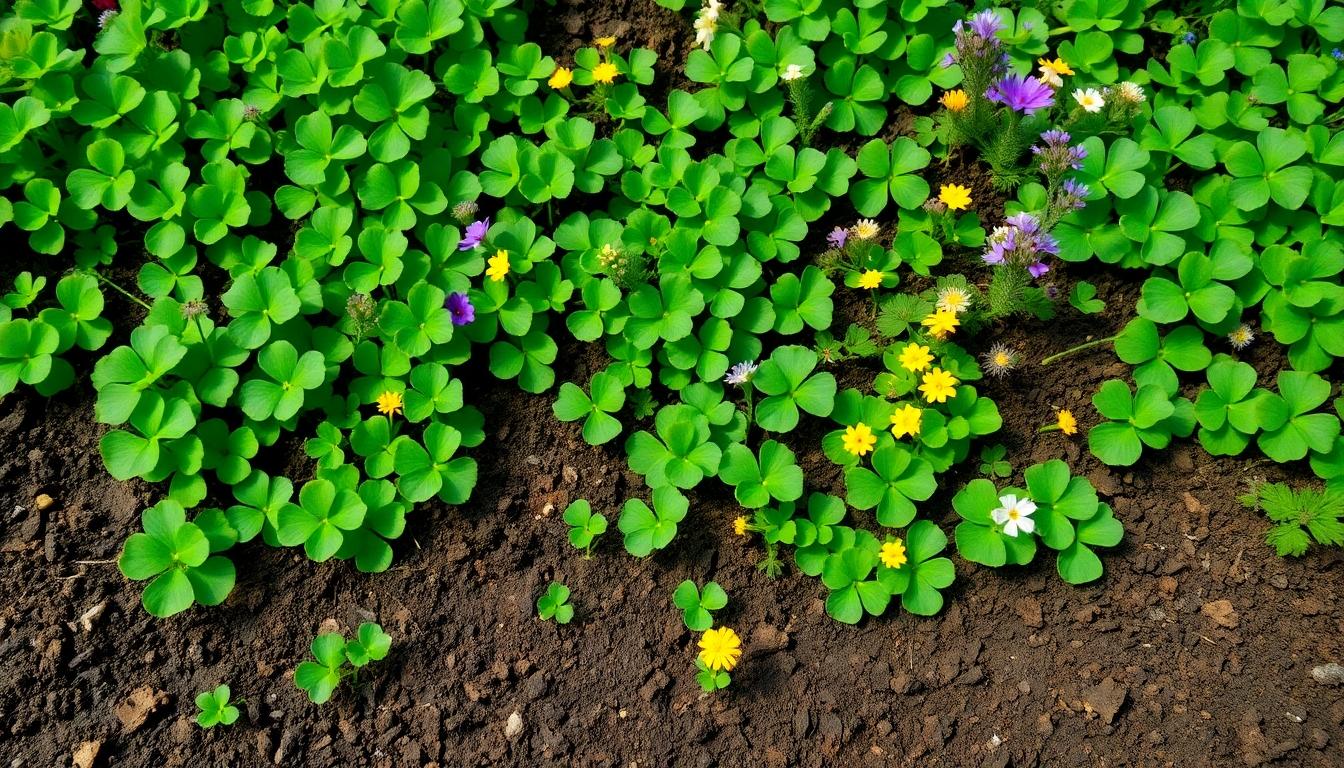
Building on our discussion of companion planting benefits, let’s explore plants that specifically enhance soil quality naturally, reducing your need for chemical fertilizers and creating a sustainable garden network.
Clover: The Nitrogen-Fixing Wonder
Clover transforms atmospheric nitrogen into forms that plants can readily use through its remarkable symbiotic relationship with rhizobia bacteria. This natural process reduces the need for synthetic fertilizers while continuously feeding nearby plants. Gardeners value clover as an excellent living mulch that simultaneously suppresses weeds and improves soil fertility. We recommend incorporating white or Dutch clover varieties as ground covers between vegetable rows to enhance microbial activity and maintain healthy nitrogen levels throughout your garden beds.
Comfrey: The Ever-changing Accumulator
Comfrey serves as a nutrient mining powerhouse with deep taproots that extract essential minerals from subsoil layers inaccessible to other plants. These extensive roots draw up potassium, phosphorus, calcium, and various trace minerals from deep soil layers. Gardeners can harness comfrey’s benefits by cutting its leaves periodically and using them as nutrient-rich mulch around hungry plants. The decomposing leaves release stored minerals directly into your topsoil, creating a natural fertilizer system that improves overall soil structure and fertility.
Legumes: Nature’s Nitrogen Factories
Beans and peas contribute significantly to soil health through specialized root nodules that convert atmospheric nitrogen into plant-available forms. These nitrogen-rich root systems make legumes perfect companions for heavy-feeding plants like corn that quickly deplete soil nutrients. Planting legumes in rotation with nutrient-demanding crops naturally replenishes soil nitrogen without chemical inputs. Their extensive root networks also improve soil structure by creating pathways for water and air movement throughout your garden beds.
Cover Crops: Soil Protection Specialists
Cover crops including vetch, rye, and buckwheat offer multiple soil-improving benefits when incorporated into your garden rotation. These versatile plants prevent erosion by keeping soil covered during off-seasons or between plantings. Their extensive root systems break up compacted soil while adding valuable organic matter when tilled back into beds. We’ve found that buckwheat excels at loosening heavy soils, while winter rye suppresses weeds and adds important biomass that improves soil structure upon decomposition.
Mycorrhizal-Friendly Plants: Underground Network Builders
Plants that support mycorrhizal fungi development create extensive underground nutrient-sharing networks that benefit your entire garden network. These beneficial fungi form symbiotic relationships with plant roots, dramatically increasing their ability to access water and nutrients. Allowing diverse plant communities to establish promotes these fungal networks, reducing disease pressure through enhanced microbial diversity. The resulting improvement in soil structure increases water retention capacity and creates drought resistance throughout your garden beds.
8 Flowers That Make Perfect Companion Plants

Sunflowers: Creating Beneficial Microclimates
Sunflowers serve as natural trellises for climbing plants like beans, offering structural support in your garden network. Their towering presence creates protective microclimates that shelter tender crops such as lettuce from intense sunlight and harsh weather conditions. Beneficial pollinators flock to sunflowers for their abundant pollen and nectar, increasing garden-wide pollination rates. Birds that feed on garden pests often perch on sunflower stalks, providing natural pest control while resting between hunting sessions. We’ve found that strategic sunflower placement throughout the garden can transform exposed areas into productive growing zones for heat-sensitive plants.
Lavender: Attracting Pollinators and Repelling Pests
Lavender functions as a dual-purpose companion plant, actively repelling harmful insects while attracting beneficial ones to your garden. Scientific research confirms that lavender effectively deters aphids, whiteflies, and moths through its aromatic compounds. Bees and butterflies are strongly attracted to lavender’s fragrant blooms, improving pollination for nearby fruiting plants. Planting lavender near vegetable beds creates a protective barrier that many pests avoid crossing. The striking purple flowers introduce aesthetic value alongside their practical benefits, making them perfect companions for both ornamental and edible gardens.
Marigolds: Natural Pest Control Powerhouses
Marigolds release alpha-terthienyl, a biochemical compound scientifically proven to suppress harmful root-knot nematodes in the soil. Their distinctive scent masks the chemical signals that many pests use to locate their preferred host plants. Garden productivity improves significantly when marigolds are planted throughout vegetable beds, creating invisible zones of protection. Regular placement of marigolds along garden borders effectively reduces pest invasions from adjacent areas. We recommend incorporating both tall African and compact French marigold varieties to maximize their pest-repelling benefits at different heights within your garden network.
Nasturtiums: Sacrificial Trap Plants
Nasturtiums function as outstanding trap crops, attracting aphids away from your valuable garden plants. Their ability to mask the scent of brassica crops confuses cabbage moths and other pests looking for host plants. Colorful nasturtium blooms bring vibrant splashes of orange, yellow, and red while serving practical purposes in companion planting schemes. Edible flowers and leaves from nasturtiums add peppery flavors to salads, providing both ornamental and culinary benefits. Strategic placement of nasturtiums around garden perimeters creates an effective first line of defense against common garden pests.
Borage: Supporting Tomatoes and Attracting Beneficials
Borage specifically deters tomato hornworms, protecting your tomato plants from these destructive pests. Predatory wasps visit borage flowers regularly, providing additional natural pest control throughout your garden. The striking blue star-shaped flowers become buzzing hubs of beneficial insect activity during the growing season. Cucumber and squash plants demonstrate improved growth and productivity when planted near borage. Water transpiration from borage’s fuzzy leaves increases local humidity, creating favorable growing conditions for moisture-loving plants nearby.
Calendula: Attracting Beneficial Predatory Insects
Calendula flowers lure beneficial insects like ladybugs and hoverflies that prey on aphids and other garden pests. Their bright orange and yellow blooms flower continuously through the growing season, providing long-lasting support to garden ecosystems. Research shows that calendula’s sticky stems trap harmful thrips and whiteflies, reducing their populations naturally. Planting calendula near tomatoes, peppers, and cabbage provides targeted protection from common pests affecting these vegetables. Medicinal properties in calendula flowers offer additional uses beyond companion planting, extending their value in your garden.
Yarrow: Improving Disease Resistance
Yarrow substantially boosts disease resistance in surrounding plants through biochemical interactions in the soil. Beneficial insects rely on yarrow as a primary nectar source, increasing their populations and effectiveness in your garden. Flat-topped flower clusters provide perfect landing platforms for tiny beneficial wasps and other predatory insects. Deep roots help break up compacted soil, improving drainage and creating better growing conditions for neighboring plants. We’ve observed that yarrow performs exceptionally well in companion planting arrangements with herbs and vegetables that prefer drier conditions.
Cosmos: Attracting Natural Pest Predators
Cosmos flowers draw beneficial lacewings and parasitic wasps that feed on aphids and caterpillars threatening your garden. Their tall, swaying structure adds vertical diversity to garden beds, creating habitat niches for various beneficial organisms. Long blooming periods ensure continuous support for predatory insects throughout the growing season. Minimal water requirements make cosmos ideal companions for drought-tolerant vegetables and herbs. Strategic placement of cosmos throughout vegetable gardens establishes natural control systems that reduce the need for pest management interventions.
6 Companion Plant Combinations to Avoid in Your Garden
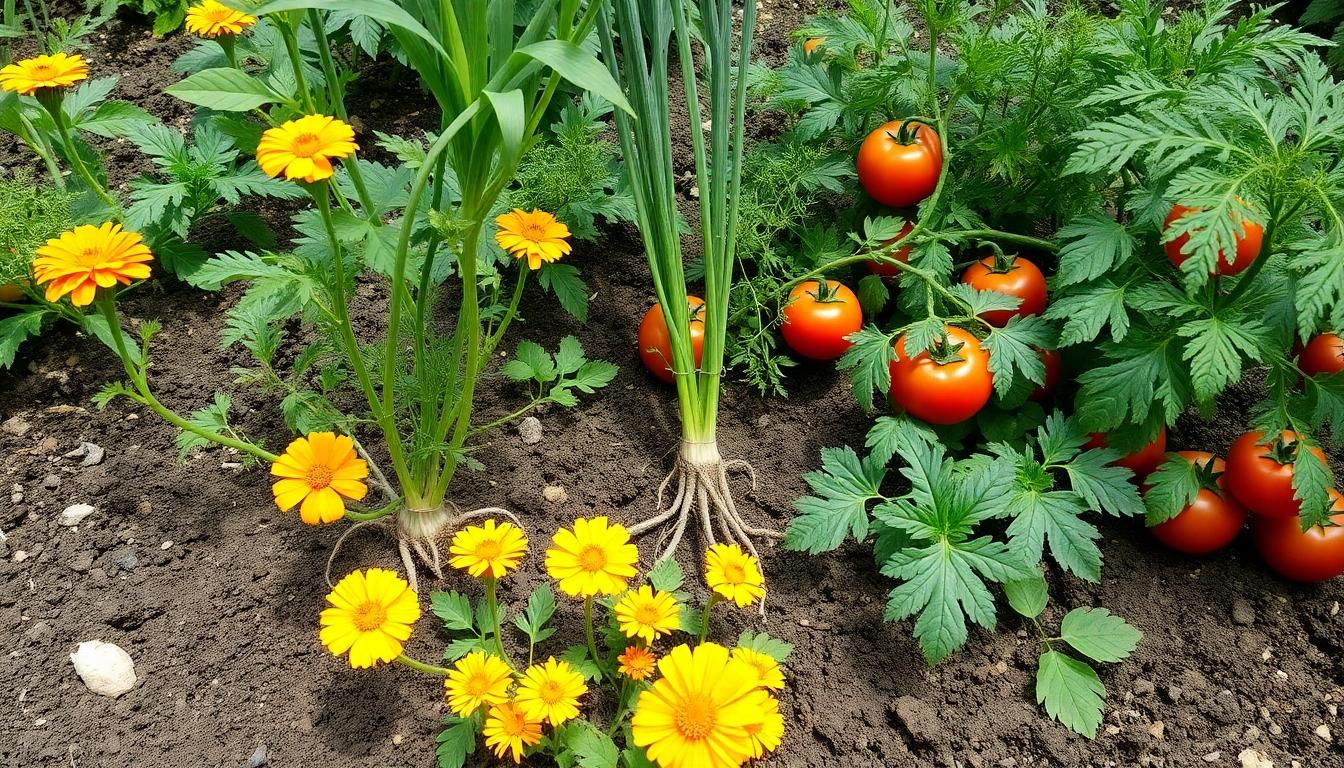
While companion planting offers many benefits, not all plant combinations work harmoniously together. We’ve discovered several pairings that can actually hinder growth and productivity in your garden:
- Marigold and Fennel – Even though marigold’s reputation as a beneficial companion plant that repels nematodes, it can actually inhibit the growth of fennel. The chemical compounds released by marigolds may suppress fennel’s development, making this a combination to avoid.
- Onions and Beans – Onions release compounds that can significantly stunt the growth of beans and other legumes. Planting these vegetables together will likely result in poor bean development and reduced harvests.
- Mint and Most Plants – Mint’s aggressive growing habit makes it problematic for most garden companions. Its invasive root system quickly spreads and can choke out neighboring plants, dominating garden beds if not properly contained.
- Tomatoes and Fennel – Fennel produces substances that specifically inhibit tomato growth. Gardens with both plants typically show stunted tomato development and reduced fruit production when planted in close proximity.
- Tomatoes and Members of the Brassica Family – Tomatoes and brassicas (including cabbage, broccoli, and cauliflower) share susceptibility to similar diseases. Growing them together increases disease transmission risk and can lead to widespread garden problems.
- Potatoes and Tomatoes – Both belonging to the Solanaceae family, potatoes and tomatoes can readily transmit diseases like early blight to each other. Their shared vulnerability makes them poor companions even though their popularity in home gardens.
Competing Root Systems: When Plants Fight Underground
Underground competition between plants can be just as fierce as what we observe above ground. Established trees often outcompete smaller plants for essential moisture and nutrients, creating resource-depleted zones in the soil. This competition occurs through extensive root networks that can extend far beyond the tree’s canopy. We’ve found that managing root competition requires strategic interventions, such as pruning tree roots or installing physical root barriers to protect vulnerable perennials.
Allelopathic Relationships: When Plants Release Growth Inhibitors
Allelopathy represents a fascinating but potentially problematic plant interaction in gardens. This natural phenomenon occurs when certain plants release biochemical compounds that inhibit the growth of neighboring plants. These growth-inhibiting chemicals can be released through various plant parts including roots, leaves, flowers, and even decaying matter. Black walnut trees provide a classic example of allelopathy, secreting juglone that prevents many plants from growing nearby. Understanding these chemical relationships helps us avoid incompatible combinations and design gardens where all plants can thrive without chemical interference.
How to Design Your Garden Using Companion Planting Principles
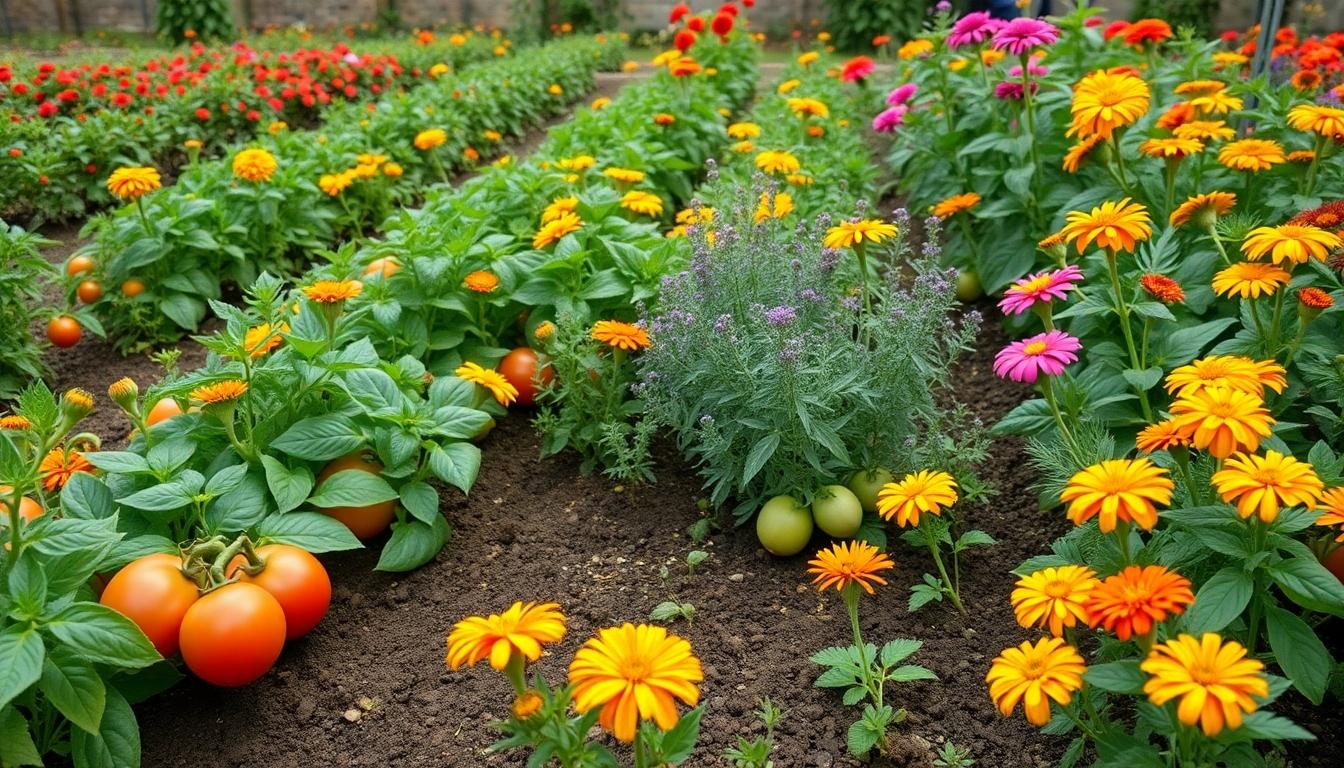
Create an Effective Garden Layout
Positioning compatible plants within 2-3 rows of each other maximizes their mutual benefits. We recommend placing tomatoes near basil or onions to enhance flavor and deter pests naturally. Your garden layout should avoid placing incompatible species together, such as tomatoes near potatoes or brassicas, as they can inhibit each other’s growth or share diseases. Mapping your garden before planting allows you to visualize these relationships and optimize your space for the best results.
Carry out Strategic Pest Management
Natural pest control is one of companion planting’s greatest advantages. Marigolds effectively repel harmful nematodes when planted near tomatoes, protecting your crop without chemicals. Basil serves as an excellent aphid deterrent when positioned near susceptible plants. Integrating these pest-repellent companions throughout your garden creates multiple layers of protection, significantly reducing the need for pesticides while maintaining a healthier network.
Optimize Soil and Space Usage
Smart companion planting makes the most of your available garden space through vertical layering. Tall plants like corn provide natural shade for sun-sensitive crops such as lettuce during hot summer months. Legumes such as beans fix nitrogen in the soil, benefiting heavy-feeding neighbors like corn without additional fertilizers. This natural resource sharing creates a more sustainable garden system where plants support each other’s nutritional needs.
Group Plants by Compatibility
Following proven plant partnerships ensures your garden thrives through natural cooperation. The table below highlights key compatible and incompatible relationships:
| Crop | Compatible Plants | Plants to Avoid |
|---|---|---|
| Tomatoes | Basil, onions, carrots | Brassicas, potatoes |
| Cucumbers | Radishes, beans, peas | Potatoes, aromatic herbs |
| Carrots | Lettuce, rosemary | Dill, parsnips |
Incorporate the “Three Sisters” Method
The traditional “Three Sisters” planting technique demonstrates perfect companion planting principles in action. We’ve found this method particularly effective for maximizing garden productivity. Corn provides natural stakes for climbing beans, while beans fix nitrogen that feeds the corn and squash. Squash’s large leaves cover the ground, preventing weed growth and retaining soil moisture. This ancient planting system creates a complete network within a small garden space.
Add Flowers and Herbs Strategically
Incorporating flowering plants and herbs throughout your vegetable garden boosts biodiversity and attracts beneficial insects. Lavender draws pollinators that increase vegetable yields, while nasturtiums act as trap crops for aphids. These additions not only enhance the beauty of your garden but also contribute significantly to its productivity and resistance to pests and diseases.
Conclusion: Creating Harmony in Your Garden Through Companion Planting
Companion planting transforms ordinary gardens into thriving ecosystems where plants support each other naturally. By strategically pairing compatible species we’ve shown how you can enhance flavor improve yields and reduce pest problems without chemicals.
Remember that successful companion planting requires understanding both beneficial partnerships and combinations to avoid. Start small with proven pairings like tomatoes with basil or the Three Sisters method before expanding your plant community.
We hope you’ll carry out these natural gardening strategies in your growing space whether it’s a small balcony container garden or sprawling farm plot. The beauty of companion planting lies in its adaptability and the way it mimics nature’s own design. Your garden isn’t just a collection of plants but a living network where each member contributes to overall health and productivity.
Frequently Asked Questions
What is companion planting?
Companion planting is a gardening strategy where specific plants are grown together because they benefit each other. This scientifically-supported method enhances garden productivity by creating partnerships between plants that improve pest control, flavor, and yields. Plants communicate through chemical signals, with some acting as natural pest deterrents while others provide resources like shade or nutrients to their neighbors.
What are the main benefits of companion planting?
The main benefits include natural pest control, improved plant health, enhanced flavor of harvested produce, increased biodiversity, better resource efficiency, and reduced maintenance needs. This approach creates a balanced ecosystem where plants support each other, reducing the need for chemical interventions while maximizing productivity and improving soil health naturally.
Which plants work well with tomatoes?
Tomatoes thrive when planted with basil, carrots, marigolds, and nasturtiums. Basil enhances tomato flavor while repelling pests. Carrots and tomatoes form a mutually beneficial relationship where each improves the other’s growth. Marigolds deter nematodes that attack tomato roots, while nasturtiums act as trap crops for aphids and other pests that might otherwise target tomatoes.
Are there plant combinations I should avoid?
Yes, certain plant combinations can inhibit growth. Avoid planting marigolds with fennel, onions with beans, tomatoes with fennel or brassicas (cabbage family), and potatoes with sunflowers. These incompatible pairings can result in chemical interference (allelopathy), competition for resources, or growth inhibition, reducing overall garden productivity.
How can herbs benefit my vegetable garden?
Herbs are powerful companion plants that protect and enhance vegetables. Chamomile boosts health of cabbage and cucumbers; chives improve carrot flavor and deter aphids; coriander repels pests while attracting beneficial insects; mint protects tomatoes and peas; rosemary deters cabbage moths; and basil improves tomato flavor while repelling harmful insects.
Which flowers should I include in my companion planting design?
Include sunflowers for structural support and beneficial microclimates; lavender to repel pests and attract pollinators; marigolds to suppress nematodes; nasturtiums as trap crops; borage to protect tomatoes; calendula to attract beneficial insects; yarrow to boost disease resistance; and cosmos to draw natural pest predators. These flowers enhance both garden productivity and beauty.
How do I design a garden using companion planting principles?
Place compatible plants within 2-3 rows of each other (like tomatoes near basil). Use strategic pest management by incorporating natural deterrents like marigolds. Optimize space through vertical layering and grouping plants by compatibility. Consider the “Three Sisters” method (corn, beans, squash) as a model. Add flowers and herbs throughout to boost biodiversity and attract beneficial insects.
Which plants can improve my soil naturally?
Clover acts as a nitrogen-fixing wonder, enriching soil as it grows. Comfrey accumulates nutrients that become available when leaves decompose. Legumes (beans, peas) add nitrogen through specialized root nodules. Cover crops like vetch, rye, and buckwheat protect soil and add organic matter. Mycorrhizal-friendly plants build underground nutrient-sharing networks that improve overall soil health and structure.







